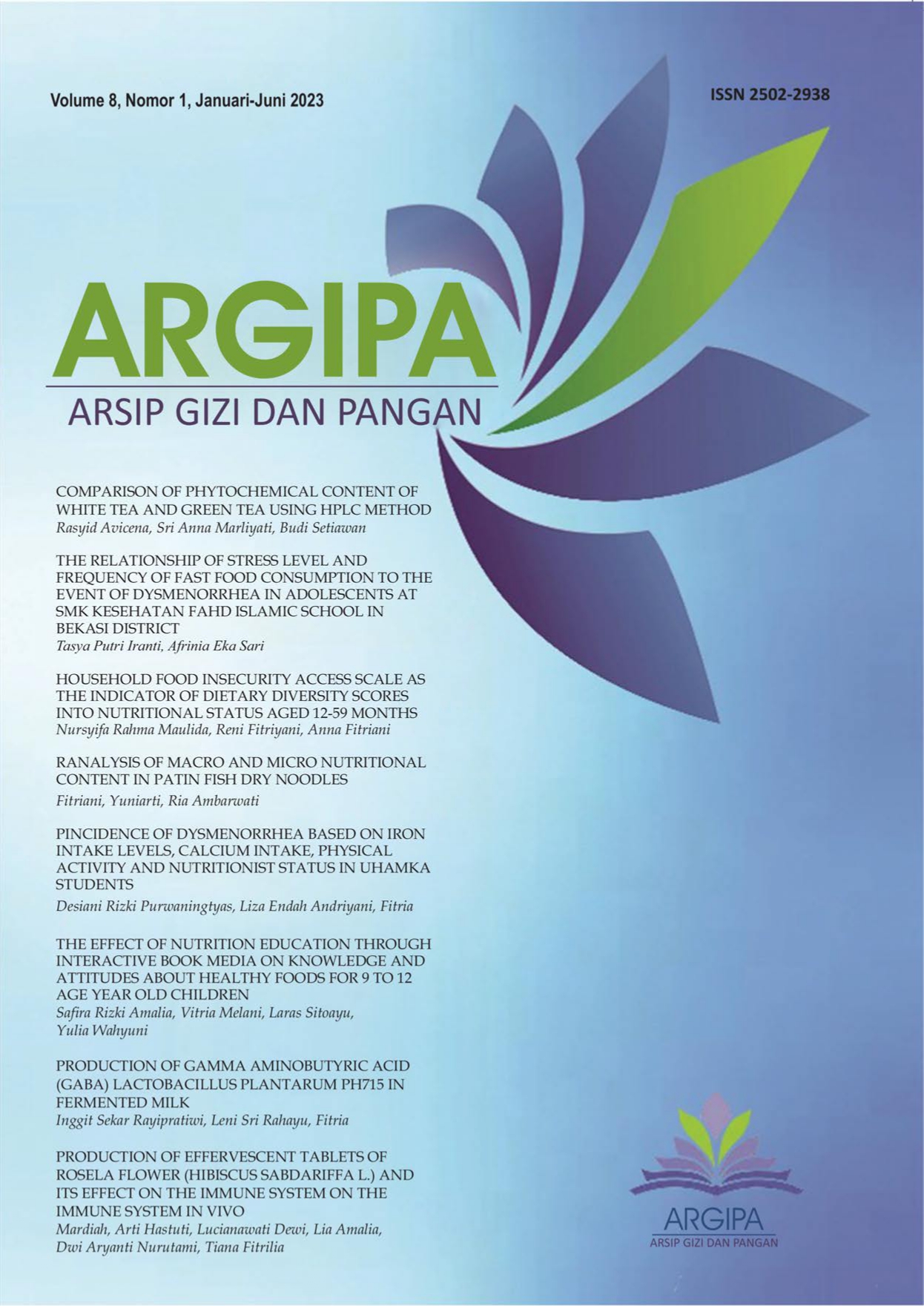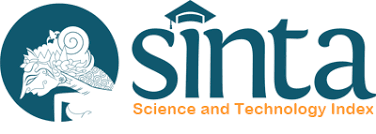Production of effervescent tablets of rosela flower (Hibiscus sabdariffa L.) and its effect on the in vivo immune system
DOI:
https://doi.org/10.22236/argipa.v8i1.11895Keywords:
Effervescent, Roselle, anthocyanin, antioxidant, Immune SystemAbstract
Rosella effervescent tablet is an effervescent product in the form of tablet made from roselle petal extract. This study aimed to evaluate the antioxidant content of the resulting effervescent tablets and the effect of effervescent tablets on the in vivo immune system. The technique for making effervescent tablets used the wet granulation method. Immune system analysis used rat test animals. The type of rat is Sprague Dawley. There were three treatment groups, each group consisted of 5 rats. The first group was the standard group, group 2 was the positive control group which was given Stimuno Forte at a dose of 1.35 mg/kg BW, and the treatment group 3 was given roselle effervescent tablets at a dose of 8.1 mg/kg BW by sonde for 28 days. Blood sampling (leukocytes, differential leukocytes, lymphoid organs (spleen and liver), total serum protein, and serum albumin) was performed on day 0 and day 29. The chemical test results of the effervescent tablets showed an IC50 of 10.35 ppm, a vitamin C content of 2.28 mg/tablet, and an anthocyanin content of 22.12 mg/L. The results of the research on rosella effervescent tablets at a dose of 8.1 mg/kg BW provided a protective effect on the immune system of rat with an average parameter of leukocyte count of 7.58×103/µL, total serum protein of 10.25 g/dl, and relative liver weight of 3. 11% and still within the normal range of Sprague Dawley rats.Downloads
References
Aldi, Y., Dewi O. Novita, & Uthia R. (2016). Uji imunomodulator dan Jumlah sel leukosit dari ekstrak daun kemangi (Ocimum basilicum L.) pada mencit putih jantan. Scientia vol 6 no.2, agustus 2016 [prosiding seminar nasional perkembangan teknisi sains farmasi dan klinik III 2013]. http://www.jurnalscientia.org/index.php/scientia/article/viewFile/58/76. [diakses 26 juni 2018].
Atmadja, A.S., Kusuma, R., & Dinata. F. (2016).Pemeriksaaan Laboratorium untuk membedakan infeksi bakteri dan infeksi virus. 43(6): 457-461.
Dwiyanti, G., K, Hati. N. (2014). Aktivitas Antioksidan Teh Rosela (Hibiscus Sabdariffa L.) Selama Penyimpanan Pada Suhu Ruang. 5(1) :1-6.
Faradilla, M., & Iwo M. Immaculata. (2014). Efek imunomodulator Polisakarida rimpang temu kunci [Curcuma zedoaria(Christm.) Roscoe] Rhizome. 12(2):273-278.
Hartanti, D., & Mardiah. (2018). Reformulasi Tablet Effervescent Berbasis Kelopak Bunga Rosela (Hibiscus Sabdariffa L.) [skripsi]. Jurusan Teknologi Pangan Dan Gizi, Universitas Djuanda, Bogor.
Hastuti, A., Lestari, T. A., & Fulazzaky, M. A. (2022). Assistance Of Quality Control Of Yoghurt Production Process. Jurnal Qardhul Hasan, 8(3), 237-241.
Kiswari, Rukman. (2014). Hematologi dan Transfusi. Erlangga. Jakarta.
Losco, P. (1992). Normal Development, Growth and Aging of the Spleen. Pathobiology of Aging Rat. Didalam: Cesta, M. F. 2006. Normal structure, function, and histology of the spleen. Toxicol Pathil 34:455-465.
Mardiah. (2012). Minuman Fungsional Berkarbonasi Yang Kaya Antioksidan Berbasis Kelopak Bunga Rosela (Hibiscus Sabdariffa L.). 2(3): 1-4.
Mardiah, M., Nur’utami, D. A. & Hastuti, A. (2019). Pengaruh Pemberian Serbuk Ekstrak Kelopak Bunga Rosela (Hibiscus sabdariffa L.) Terhadap Sistem Imun Tikus Sprague Dawley, Jurnal Agroindustri Halal, 5(1), 17–29.
Mardiah, Zakaria, F. R. & Prangdimurti, E. (2014). The Effect of Roselle (Hibiscus sabdariffa Linn.) On Blood Glucose Level And Total Antioxidant Level On Diabetic Rat Induced By Streptozotocin. 4(10):6-16.
Mardiah, Zakaria, F. R., Prangdimurtia, E., & Damanik R. (2015). Anti-i nflammatory of purple roselle extract in diabetic rats induced by streptozotocin, the first international symposium on food and agro-biodiversity (ISFA2014). Procedia Food Science.3:182-189.
Peraturan Menteri Kesehatan RI No 75. (2013). Angka Kecukupan Gizi yang Dianjurkan Bagi Bangsa Indonesia. Jakarta.
Kameritsch, P. & Renkawitz, J. (2020). Principles of Leukocyte Migration Strategies. Jurnal Trends in Cell Biology, 30(10): 821-832.
Rahadian, R., Harun, N., & Efendi, R. (2017). Pemanfaatan Ekstrak Kelopak Bunga Rosela (Hibiscus Sabdariffa L.) Dan Rumput Laut (Euchema cottoni) Terhadap Mutu Permen Jelly. 4(1) : 1-11.
Riswanto. (2013). Pemeriksaan Laboratorium Hematologi. Alfamedia, Yogyakarta
Santoso, B., Utomo, R. S. & Wiyoga, M. D. (2016). Analisis hubungan golongan flavonoid dari 24 famili tanaman terhadap aktivitas penangkap radikal bebas. Di dalam prosiding seminar nasional kimia UNJANI-HKI, Hotel graha Tjokro, Bandung, 3-4 Agustus 2016: 139-146.
Sihombing, M., Tuminah, S. (2011). Perubahan Nialai Hematologi, Biokimia Darah, Bobot Organ dan Bobot Badan Tikus Putih pada Umur Berbeda. Jurnal Veteriner. 12 (1):58-64.
Ulilalbab, A., Wijatmadi, B. Adriani, M. (2017). Ekstrak kelopak rosella merah mencegah kenaikan malondialdehid tikus wistar yang dipapar asap rokok. 13 (2) : 215-220.
Widyastuti, D. A. (2013). Profil Darah Tikus Putih Wistar pada Kondisi Subkronis Pemberian Natrium Nitrit. JSV 31(2):210-213.

















